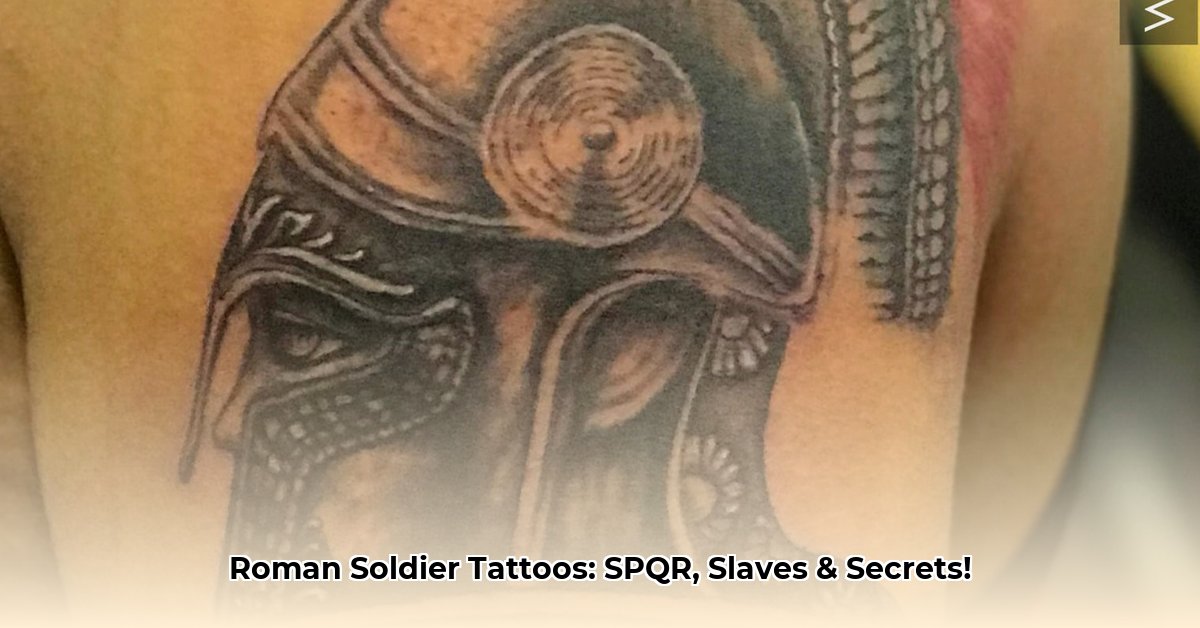The formidable Roman Empire, renowned for its architectural marvels, military might, and complex legal systems, also possessed a less obvious, yet profoundly impactful, form of communication: the tattoo. Far removed from modern notions of personal expression or aesthetic adornment, tattoos in ancient Rome served pragmatic, often stark, purposes. They were instruments of identification, potent symbols of social control, and indelible markers of status. By meticulously examining archaeological findings, linguistic evolutions, and the fragmented historical texts that survive, we can decode the silent language etched onto Roman skin, revealing a society where ink conveyed allegiance, disgrace, and one’s fixed place within a rigidly stratified world. Learn more about the military ranks that existed during the empire.
The Soldier’s Permanent Pledge: Tattoos in the Roman Military
Imagine a legionary serving far from home, amidst the vast and diverse ranks of Rome’s professional army. How did the vast Roman military machine ensure unwavering loyalty and prevent desertion? One crucial method was through the imposition of permanent body markings. While not universally adopted across all periods or legions, historical evidence strongly suggests that Roman soldiers, particularly from the early Imperial period onwards, often received tattoos or brands upon their recruitment. These were not decorative choices but compulsory symbols of military identity and state ownership.
The most iconic and frequently cited motif was the acronym SPQR (Senatus Populusque Romanus), meaning “The Senate and People of Rome.” Etched onto a soldier’s hand, arm, or leg, this mark served as an undeniable declaration of allegiance to the Roman state and its governing bodies. It was the ancient world’s equivalent of a dog tag, a constant, visible reminder of their solemn duty and a powerful deterrent against abandoning their military obligations. In an era predating sophisticated identification systems, these tattoos were indispensable for maintaining discipline, tracking personnel, and ensuring that any attempt at desertion would be easily identifiable and severely punishable.
Beyond SPQR, some records hint at other military tattoos, possibly including the specific name or emblem of their legion, or perhaps even a mark indicating a specific branch of service. These marks not only served a practical purpose but also fostered a profound sense of camaraderie and shared identity among the legionaries, creating a visible brotherhood united by ink and unwavering loyalty. For soldiers engaged in non-combat duties, such as engineering or administration, where armor and military attire might not be worn, a permanent mark on the hand or forearm ensured their identity as a Roman soldier remained undeniable.
Marks of Shame: Controlling Slaves and Criminals Through Ink
While military tattoos underscored loyalty and belonging, the practice of tattooing took on a far darker, more punitive meaning for other segments of Roman society. For enslaved individuals and convicted criminals, tattoos were instruments of dehumanization and oppressive control, visibly enforcing their subjugated status.
Captured runaway slaves, if apprehended, were frequently branded with indelible marks such as the Latin word “Fugitivus” (fugitive) or “Fugit” (he has fled). These stark marks were often applied to highly visible areas like the forehead or face, ensuring immediate identification and serving as a chilling deterrent to others considering escape. This practice solidified their status as chattel property, transforming their bodies into walking declarations of their owner’s dominion. The dehumanization inherent in this practice highlights the brutal realities of Roman slavery, where individuals were reduced to mere commodities.
Similarly, convicted criminals were often tattooed with symbols or words signifying their specific transgressions. This punitive marking served as a constant public reminder of their crimes, effectively ostracizing them from mainstream Roman society. It acted as a severe form of public humiliation and a stark warning to others contemplating similar offenses. The Roman legal system explicitly sanctioned and rigorously regulated this form of punitive marking, thereby institutionalizing the profound social stigma historically attached to forced tattoos.
The Perception of Ink: Decorative Intentions Versus Social Stigma
Did the Romans ever embrace tattoos purely for their aesthetic value or as a form of personal adornment, much like modern societies? Historical evidence strongly suggests otherwise, particularly among the Roman elite. Unlike various ancient cultures, such as ancient Egypt or the Celtic tribes, where tattoos held deep spiritual, therapeutic, or significant status-related meanings, Roman society largely viewed them with pronounced disdain.
The prevailing Roman attitude often categorized tattooing as a “barbaric” practice, more suitable for foreign peoples, enslaved populations, or common criminals. This perception was deeply intertwined with the Roman concept of infamia, a profound loss of legal standing, reputation, and rights resulting from certain professions or behaviors. Forced tattoos, especially those applied as punishment or branding, almost certainly contributed to this potent stigma. The linguistic evolution of the Greek word “stizein” (meaning “to tattoo”) into the Latin “stigma” perfectly illustrates this historical shift toward overwhelmingly negative associations, where permanent markings on the body frequently signified dishonor, enforced servitude, or a definitively lower social status.
While some scattered accounts hint at gladiators or certain soldiers sporting tattoos that might have symbolized personal bravery or unwavering loyalty, comprehensive evidence for widespread use of purely decorative tattoos within Rome itself remains notably limited. This striking absence reveals a clear cultural preference for practical functionality and social control over artistic expression when it came to permanent body modification. The Romans, ever pragmatic, seemingly prioritized rigorous order and absolute control over personal adornment, especially if it carried connotations of “uncivilized” practices or lower social standing.
Roman Law and Evolving Attitudes: Constantine’s Ban
The fourth century CE witnessed a dramatic and pivotal shift in Roman societal attitudes towards tattooing, largely influenced by the rise of Christianity. In 325 CE, Emperor Constantine I, who famously embraced Christianity and integrated it into the fabric of the empire, issued a sweeping ban on the practice of tattooing the human face.
Constantine’s edict was rooted in theological reasoning: he viewed the human face as created in God’s divine image (imago Dei) and, therefore, sacrosanct and not to be defiled by permanent marks. This significant imperial decree signaled a broader, evolving move away from widespread punitive branding, particularly of visible areas, reflecting changing religious sensibilities and developing ethical considerations within the burgeoning Christian empire. It marked a turning point in the legal and social perception of indelible body marks, shifting from a state-sanctioned punitive tool to a practice viewed with increasing moral disapproval, at least when applied to the most visible parts of the body.
The ban on facial tattooing did not immediately abolish all forms of body marking, but it undeniably contributed to a greater societal aversion to the practice. Over time, as Christianity became the dominant religion, the general perception of tattoos in the Roman world became increasingly negative, associating them with pagan rituals, criminality, and a lack of refined civilization.
The Unseen Ink: Composition and Application in Ancient Rome
While the precise methods and materials used for tattooing in ancient Rome remain somewhat challenging for modern scholars to fully reconstruct, historical and archaeological evidence offers fascinating insights. Ancient tattoo ink likely consisted of natural pigments derived from materials such as soot, charcoal, or ground minerals (like corroded bronze), possibly mixed with binding agents such as blood, bile, or plant extracts.
The application process would have been a stark contrast to contemporary tattooing techniques. Without modern equipment, Roman tattoos were likely administered using crude, rudimentary tools. This could have involved sharpened bronze needles, bone slivers, or even multiple needles bound together, used to puncture the skin and introduce the pigment. Given the lack of sterilization and pain management, each tattoo would have been a painful, laborious, and potentially dangerous endeavor, risking infection and disease. This primitive application process further reinforces the idea that these permanent markings were not frivolous decorations, but rather serious, deliberate, and often compulsory acts of branding or identification, borne of necessity or state decree rather than personal desire.
| Purpose of Tattoos | Examples & Significance | Social Connotation | Legal Context |
|---|---|---|---|
| Military Identification | SPQR (Senatus Populusque Romanus) on soldiers to prevent desertion, signify allegiance, and foster camaraderie. Specific legion emblems or names. | Allegiance, Duty, Belonging, Professionalism | Mandated by military regulations; intrinsic to military order and discipline. |
| Punishment & Control | “Fugitivus” on runaway slaves (often on the face/forehead) to deter escape and identify. Marks for specific crimes on criminals. | Ownership, Inferiority, Shame, Outcast, Warning, Dehumanization | Sanctioned and regulated by Roman law as a form of retribution and control. |
| Societal Perception | Evidence for purely decorative tattoos is scarce, generally viewed as “barbaric” or appropriate for lower classes/foreigners. Religious tattoos more common in provinces (Egypt, Syria). | Stigma, Barbarism, Low Status (for forced tattoos); aesthetic disinterest (for elite). | No explicit legal prohibition until Constantine regarding facial tattoos. |
What Was The Enduring Legacy of Roman Tattoos?
Key Takeaways:
- Tattoos in ancient Rome served as crucial, pragmatic tools for identification of soldiers and control of marginalized populations.
- They were potent instruments of social stratification, visibly distinguishing between citizens, soldiers, slaves, and criminals.
- The Roman legal system profoundly influenced the application and perception of tattoos, cementing their role as markers of status or shame.
- Roman attitudes towards tattoos underwent significant evolution, notably with Constantine’s Christian-influenced ban on facial marking.
- Understanding Roman tattooing practices is essential for comprehending the complex social hierarchies and control mechanisms of the empire.
A Society Etched in Stone and Skin
The story of tattoos in ancient Rome is not one of artistic expression or individual choice, but rather a compelling chapter in the history of societal control and identity. From the disciplined ranks of the legions, where SPQR marked unyielding loyalty, to the brutal branding of enslaved individuals and the punitive etching on criminals, Roman ink profoundly reflected the empire’s overarching emphasis on order, control, and rigid social stratification. These indelible marks served as a constant, visible reminder of one’s place within the vast Roman societal framework.
Beyond the Visible: The Deeper Implications
The use of tattoos in ancient Rome paints a vivid picture of a society deeply preoccupied with identity, ownership, and the maintenance of a meticulous social order. Military tattoos bolstered cohesion and prevented desertion, while punitive marks on slaves and criminals underscored the absolute authority of the state and the severe consequences of defying it. The shift in legal and social attitudes, particularly with Constantine’s edict, further illustrates how external influences, such as the ascendance of Christianity, could dramatically reshape deeply ingrained cultural practices and perceptions.
These ancient markings, though largely faded from the skin centuries ago, continue to offer invaluable insights into the daily lives, legal systems, and deepest societal values of one of history’s most powerful empires. They serve as a poignant reminder that even the most seemingly personal forms of body modification can carry profound public meanings, shaping the very fabric of identity and status in a world far removed from our own. The enduring legacy of Roman tattoos is a testament to the fact that sometimes, the most silent forms of communication speak the loudest about a society’s true nature.
















